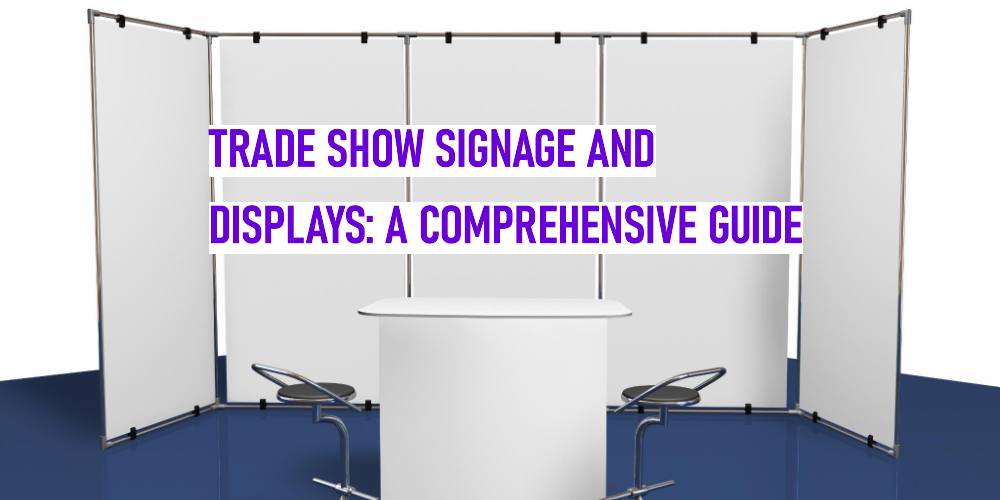What are the Trade Show Signage and Displays?
When you’re at a trade show, it’s the signage and displays that first catch your eye. They’re like beacons, drawing you towards different booths and helping businesses stand out in a sea of competition. You see, these visual elements are crucial for companies to grab your attention and showcase their products or services. They can range from simple banners and posters to more complex and interactive booths. But what is the goal? To leave a lasting impression on you, the potential customer, and hopefully, turn that interest into valuable leads.
Types of Trade Show Signage and Displays
- Banners: You’ve likely seen these everywhere. They’re easy to spot, simple to make, and can be hung just about anywhere. Custom trade show banners are the go-to for any business looking to make a straightforward yet effective statement.
- Pop-up Displays: Ideal for smaller businesses or those on the go, these displays are a breeze to set up. They unfold into a freestanding structure, instantly creating a focal point.
- Retractable Banners: These are a neat option. Pull them up for showtime, then retract them back into their base for easy transportation. They’re a dream for anyone who values convenience.
- Step and Repeat Banners: Perfect for photo ops, these large banners often feature repeating logos or designs. They’re a favorite for creating memorable, branded experiences.
- X-banners: Small and lightweight, X-banners are a practical choice for booths with limited space. Plus, they’re budget-friendly, which is always a bonus.
- Table Throws: These table throws add a professional flair to your booth. They’re also great for concealing storage or less-than-perfect flooring.
- Table Runners: If you’re looking to add a decorative touch, table runners can be your best companion. They’re a simple way to inject color or pattern into your space.
- Tension Fabric Displays: A modern twist in trade show displays, these use stretchy fabric over a frame for a sleek, wrinkle-free look. They’re gaining popularity fast, and you can see why!
- Truss Systems: For a more custom booth design, truss systems are fantastic. They can support various elements, from banners to lighting, giving you creative freedom.
- Interactive Displays: Want to really engage with potential customers? Interactive displays are the way to go. They can include anything from touchscreens to games, creating an engaging experience that’s hard to forget.
How To Choose the Right Type of Trade Show for Your Business?
The best type of trade show signage and displays for your business really depends on what you’re looking for. Here’s my take on the key considerations:
Rental vs. Purchase: This is a big decision. If you’re like us, you’ll weigh the pros and cons of renting versus buying. Renting a display might be more budget-friendly and suitable for occasional trade show appearances. However, if you’re planning to be a regular on the trade show circuit, investing in a purchase could be more cost-effective in the long run.
Size and Type of Display: The right size of the trade show booth is very important. You want something that not only fits within your budget but also truly represents your brand. When I think about this, I imagine how the booth will interact with the space around it and how it will catch the eye of passersby.
Research and Vendor Selection: I always find it helpful to attend other trade shows to gather ideas. It’s like window shopping for your business. Seeing what others are doing and what stands out to you can be incredibly insightful. Plus, researching vendors and events gives you a clearer picture of what’s available and what aligns best with your vision.
Audience and Industry Relevance: Knowing your audience and ensuring the trade show aligns with your industry is crucial. I always suggest looking at the exhibitor list in advance. It’s a great way to gauge whether the event will put you in front of the right eye and whether it’s a good fit for your business.
Budget and Branding: Your budget dictates a lot, but it’s essential to ensure that whatever you choose reflects your brand well. Cohesive design and a clear message are key. It’s like dressing for an interview, you want to make the best impression possible.
Goals and Objectives: What do you want to achieve? For me, it’s all about setting clear goals, whether it’s increasing brand awareness, generating leads, or something else that guides every other decision. It’s like having a roadmap for the entire process.
Competitor Analysis: Finally, knowing what your competitors are doing can give you an edge. It’s not about copying them but about understanding how you can stand out. It’s like being in a race and knowing when to speed up or take a strategic turn.

